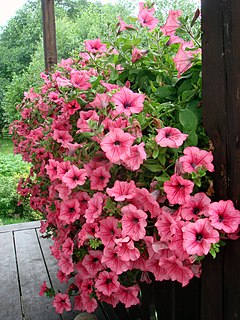
The tree ferns are the ferns that grow with a trunk elevating the fronds above ground level. Most tree ferns are members of the "core tree ferns", belonging to the families Dicksoniaceae, Metaxyaceae, and Cibotiaceae in the order Cyatheales.

Cyathea dealbata, commonly known as the silver fern or silver tree-fern, or as ponga or punga, is a species of medium-sized tree fern, endemic to New Zealand. The fern is usually recognisable by the silver-white colour of the under-surface of mature fronds. It is a symbol commonly associated with the country both overseas and by New Zealanders themselves.

Dicksonia antarctica is a species of evergreen tree fern native to eastern Australia, ranging from south-east Queensland, coastal New South Wales and Victoria to Tasmania.

Dicksonia squarrosa, commonly called whekī or rough tree fern, is a common tree fern endemic to New Zealand. It has a slender black trunk that is usually surrounded by many dead brown fronds.

Cyathea medullaris, popularly known as the black tree fern, is a large tree fern up to 20 m tall. It is distributed across the south-west Pacific from Fiji to Pitcairn and New Zealand. It is called mamaku, katātā, kōrau, or pītau in the Māori language.

Cyathea brownii, commonly known as the Norfolk tree fern or smooth tree fern, is probably the largest tree fern species in the world. It is endemic to Norfolk Island, in the Pacific Ocean near Australia and New Zealand. It is named after the botanist Robert Brown (1773-1858).
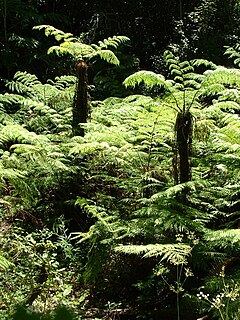
Cyathea capensis is a regionally widespread and highly variable species of tree fern. It is indigenous to Southern Africa and South America.

Cyathea cunninghamii, also known as the gully tree fern and slender tree fern, is a species of tree fern indigenous to New Zealand including North Island, South Island and Chatham Islands; also to Victoria, possibly New South Wales, southeastern Queensland and Tasmania in Australia. It grows in damp forest, often emerging from stream gullies and riverbanks. Brownsey noted that it has a lower tolerance for drought than other species of Cyathea. The erect trunk may be 20 m tall and is usually 6–15 cm in diameter, occasionally as much as 20 cm. Fronds are tri- to tetrapinnate and 3 m or more in length. The rachis and stipe are slender, black brown, warty and covered with brown scales. Sori occur along each side of the pinnule midvein and are covered by hood-like indusia. C. cunninghamii is an uncommon and slow-growing tree fern.

Cyathea dregei is a widespread species of tree fern in southern Africa.
Cyathea erinacea is a species of tree fern native to Mexico, Costa Rica, Panama, Venezuela, Colombia, Ecuador, Peru and Bolivia.
Cyathea ferruginea is a species of tree fern endemic to the Philippines.
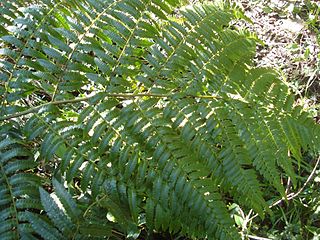
Cyathea delgadii is a widespread species of tree fern native to Costa Rica, Panama, Venezuela, French Guiana, Guyana, Trinidad, Colombia, Ecuador, Peru, Bolivia, Argentina, Paraguay, and Brazil.
Cyathea imrayana is a species of tree fern native to Dominica, Costa Rica, Panama, Venezuela, and Ecuador.

Cyathea glauca is a species of tree fern endemic to Réunion. Little is known about this species. C. glauca is not to be confused with Cyathea glauca used as a synonym of Cyathea mexicana.

Cyathea smithii, commonly known as the soft tree fern or kātote, is a species of tree fern from New Zealand.

Cibotium menziesii, the hāpuʻu ʻiʻi or Hawaiian tree fern, is a species of tree fern that is endemic to the islands of Hawaiʻi. It is named after the Scottish naturalist Archibald Menzies. It is also known as the male tree fern, and Cibotium glaucum is deemed the female tree fern due to differences in color.
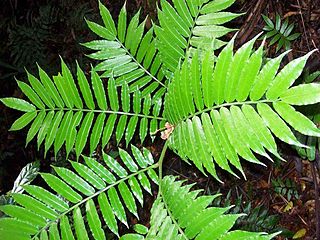
Angiopteris evecta, commonly known as the giant fern, is a rare plant occurring in eastern and northern Australia and the Malay Peninsula. Also found growing in nearby islands such as Borneo, Sumatra, New Guinea and various places in Polynesia, Melanesia and Madagascar. Listed as endangered in New South Wales, where it has been recorded growing in sub tropical rainforest, in the valley of the Tweed River. It is an invasive species in Hawaii and Jamaica.
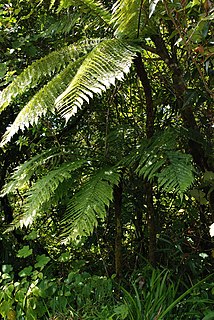
Cyathea borbonica is a tree fern endemic to Mauritius, Réunion and the islands of the south-western Indian Ocean. There are several natural forms and varieties.





